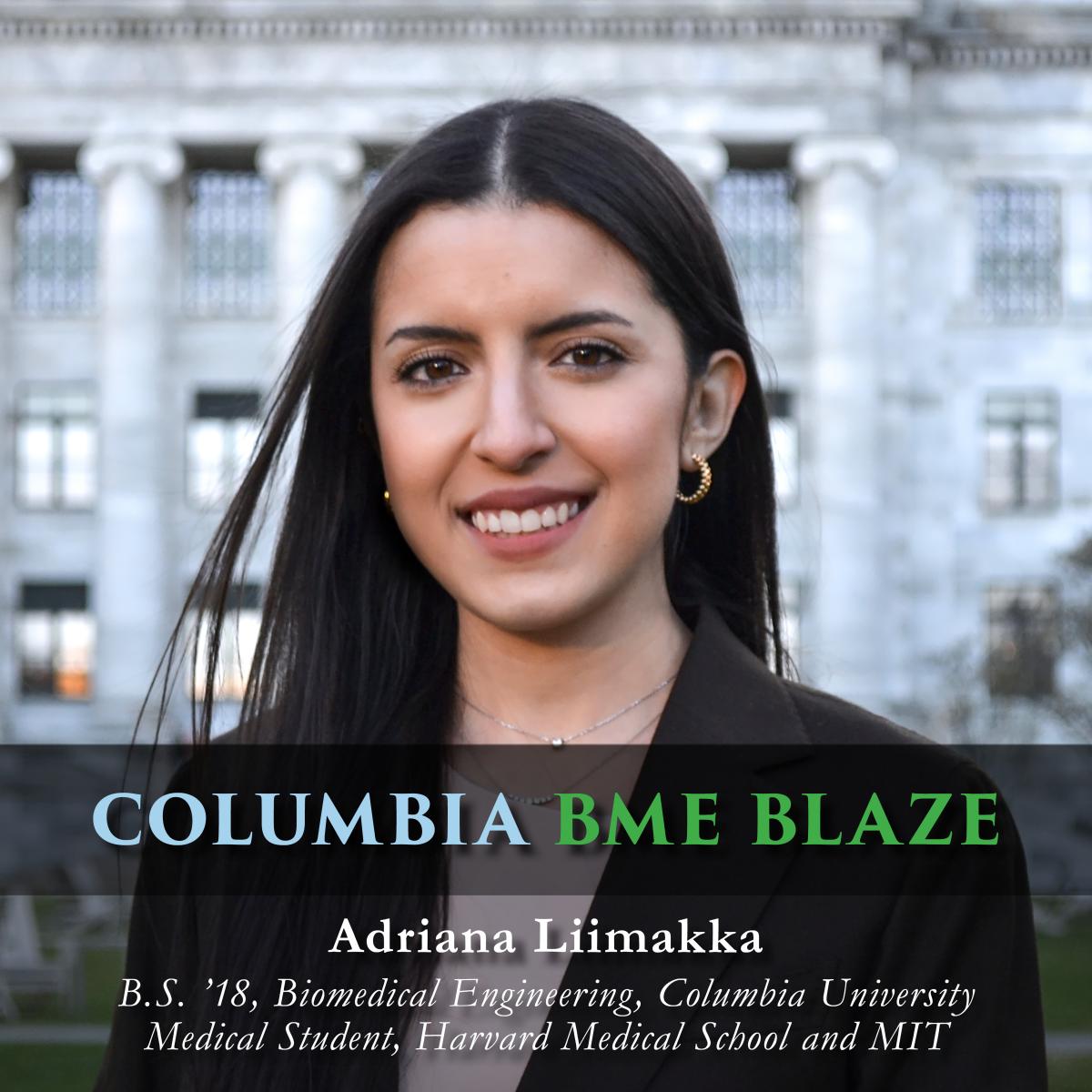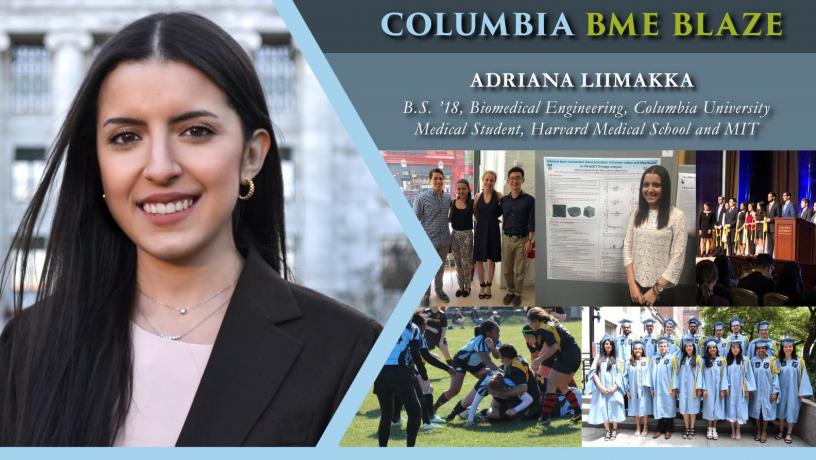August 2023 - BME Blaze: Adriana Liimakka
In this monthly spotlight, get to know the alumni and students of Columbia's Department of Biomedical Engineering. Read what our BME folks are up to, from our labs' latest research, to our students' plans for the future, to our teams' innovations, start-ups, and other career successes. We enjoyed catching up with Columbia BME alumna Adriana Liimakka as she discussed her experience in Columbia BME. Read below to get to know Adriana!

Education
- BS, Biomedical Engineering, Columbia 2018
- MD, Medicine, expected 2026 - Harvard Medical School and MIT
- MBI, Biomedical informatics, expected 2024 - Harvard Medical School
Where are you from?
Barranquilla, Colombia
What drew you to the field of Biomedical Engineering?
I chose to study Biomedical Engineering because I wanted to have a role in problem solving to benefit my community. My upbringing exposed me to profound healthcare inequities in Barranquilla, Colombia, where physical labor comprises many of the work opportunities and where illness could easily render a person unable to provide for their family. I wanted to uphold what I believe should be a person’s right to healthcare by making procedures more accessible through medical device innovation.
What is your current role?
MD student at the Health Sciences and Technology program at Harvard Medical School and MIT and MBI student in Biomedical Informatics at the Blavatnik Institute at Harvard Medical School.
Why did you choose Columbia BME?
I became familiar with the Columbia BME program since I had an interest in musculoskeletal pathology and had followed developments in biomechanics and tissue engineering coming from Professor Guo’s, Jacobs’ and Vunjak-Novakovic’s research laboratories. However, what stood out the most about Columbia BME was the generosity of the faculty. I was shocked to learn that professors who were leaders in their field would take the time to fully engage in discussions over email with me, a prospective student who had no formal research background and many of what at the time I thought were far-fetched ideas.
This proved to be the best indicator for my experience in the program. As an immigrant, it was a challenge at first to look past how lucky and grateful I was to have the opportunity to learn from such inspiring people, but I soon realized that both professors and upperclassmen were invested in my and my peers’ success. One of my fondest memories happened during a quantitative physiology lecture, when I couldn’t wrap my head around a fluid equation that showed that at any one time there is more blood flowing in veins than arteries. I felt inadequate, but Professor Morrison took the time to make an analogy with two players passing a ball at different speeds, meaning that the slowest one of them would hold on to more balls at one time. It was moments like those that gave me the confidence to ask questions and be intellectually curious in different spaces rather than feeling insecure about my shortcomings.
What were some of your favorite projects/memories from the program? What was your proudest moment at Columbia?
My favorite experience in the program was Senior Design with Professor Kyle since it was the first time I had the opportunity to translate my ideas into an actionable design.
When formulating an initial research question, I was quick to choose to target musculoskeletal diseases in Uganda and was eager to apply with my team what I had learned in biomechanics and mechanical engineering classes to healthcare solutions. Professor Kyle organized a trip to Kampala to identify areas that we could target with our design. Once there, it was clear to our team that the need resided in a different space: we witnessed an under-resourced hospital with a neonatal intensive care unit where a single oxygen tank supplied over a dozen neonates via nasal cannula without the capacity to tailor the dose per neonate. The threat of oxygen toxicity was evident. In the US, the standard is to regulate the dosage of oxygen individually by mixing with compressed purified air until a child can be weaned off.
My team entrusted me with designing a power-independent modified venturi device that could attach to each line coming out of a single oxygen tank, while adjusting to the lack of access to a reliable power plant and to purified compressed air. This 3D printed device ended up being functional to regulate oxygen from 100%-40% and was supported for further development by a VentureWell E-Team grant.
The entire experience was humbling in more ways than one. It taught me that, personally, fulfillment from engineering design does not reside in seeing the finished product but rather in having a positive impact in driving equity. Moreover, I learned that it is okay to not always have the right instinct at first, as long as you can adapt to the circumstances. Successful design requires a lot of humility to many times put your own needs to the side to better cater to the issues in front of you. In the end, I was able to apply mechanics and felt proud that it allowed me to serve others’ needs.
How has your experience with Columbia BME contributed towards your goals?
While working under the mentorship of Professor Guo on projects with orthopaedic surgeon collaborators at CUIMC, I was first introduced to the intersection of scientific innovation and patient-facing care. This experience, along with my time at NYU orthopedics with Professor Walker, was instrumental in sparking my interest in pursuing a career as a surgeon.
Columbia BME’s curriculum, community and faculty mentorship provided me with the foundation over which to pursue a career as a surgeon-scientist. The Columbia BME community among students and faculty is very tight knit due to the size of the program. This allowed me to develop a habit for collaboration, which has been instrumental in my career as a prospective academic surgeon-scientist. Many of my translational projects and mentorship relationships have stemmed from questions that I have brought up to surgeons in the field, and the most successful ones have been those that incorporate large interdisciplinary teams.
Meanwhile, my experience with design targeting global health showed me the importance of equity and generalizability in both clinical practice and research. There is a need for a bridge between humanity in clinical practice and basic science research in order to successfully incorporate patient equity in healthcare innovation. Many of the new technologies developed do not consider affordability or accommodate people who do not fit the mold of the ideal patient. Being a Columbia Biomedical Engineer has taught me to persevere in the path of advocacy through innovation, which at many times requires patience and conviction for delayed gratification.
Any words of wisdom or tips for prospective BME students?
The best advice I could give a prospective student is to give yourself permission to be a student in every sense of the word. As students, we sometimes forget that there is an inherent assumption of room for growth, and don’t give ourselves the space to fail for fear of letting people down. At Columbia BME, I found that there is always someone happy to help you dust yourself off and get back up, whether it is a professor, research mentor or your diverse group of peers and upperclassmen. Had I not allowed myself to say “I don’t know” or “could you please help me with…” I would not have been able to build relationships with wonderful and inspiring mentors and fully take advantage of everything that the department has to offer.
What are you excited about?
I am currently most excited about my future role in clinical and procedural care as a Latina woman. Even though I am not yet at the stage of conducting procedures, I have had the opportunity of assisting and taking care of patients’ perioperative care. I notice a positive change in affect when a Latinx patient sees me in the role of student doctor. There is an unspoken bond of trust between us as I will acknowledge and advocate for their perspectives in medical decision making. As I am working with mentors, such as Dr. Antonia Chen, who prioritize increasing diversity and advocating for equity, I am excited for the future in which the role of physician- and surgeon-advocate will be more prevalent and patients who identify as minorities will feel the same level of trust across the healthcare system.
COLUMBIA BME ACADEMICS
Columbia BME’s curriculum, community and faculty mentorship provided me with the foundation over which to pursue a career as a surgeon-scientist.

Images
Top row:
- Having lunch with friends at ABC kitchen during my first restaurant week in NYC.
- 2015 SURF fellowship symposium, first poster presentation as a Columbia BME student.
- King’s Crown Leadership Awards ceremony 2018.
2nd row:
- With the CU rugby team at Beast of the East 2017.
- Senior Marshals at SEAS graduation day 2018.
